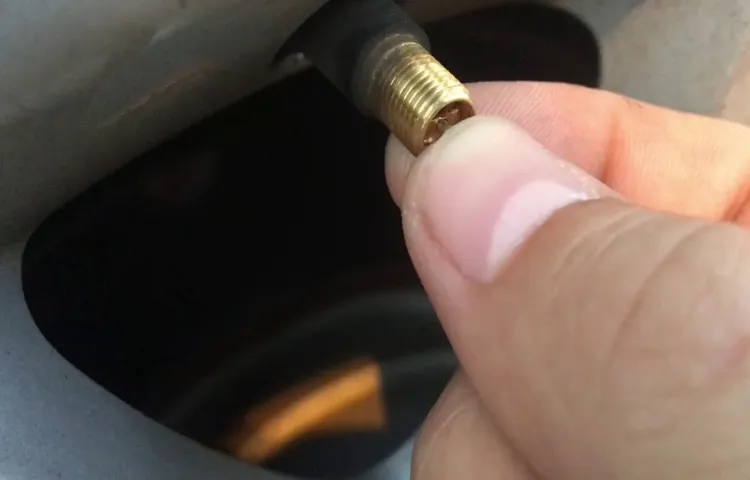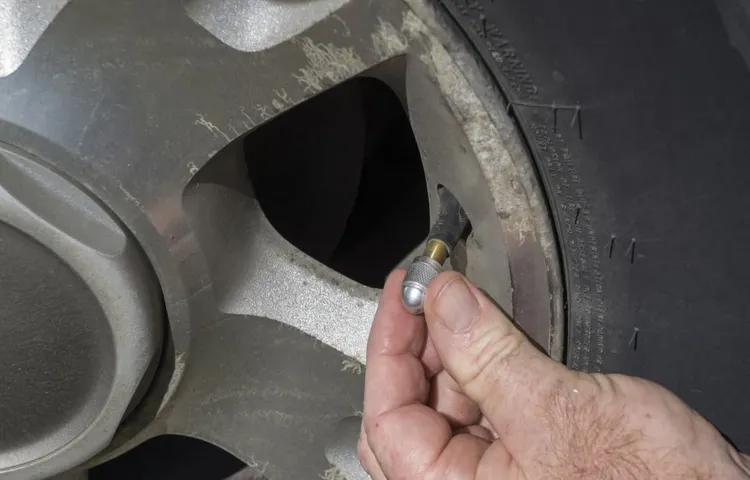Have you ever had a tire go flat unexpectedly, leaving you stranded on the side of the road? It’s not a fun experience, and it can be dangerous if you’re not prepared. One potential cause of a flat tire is a bad valve stem. But how can you tell if your valve stem is the culprit? In this blog post, we’ll explore the signs of a bad valve stem and what you can do to prevent it from happening.
Whether you’re a seasoned car enthusiast or a new driver, this information is essential for keeping you safe on the road. So, let’s get started!
Table of Contents
Introduction
Have you had trouble maintaining your tire pressure lately? It could be due to a faulty valve stem. The valve stem is the component that keeps the tire inflated, and when it becomes damaged or worn, it can cause air leakage or complete tire failure. So how do you tell if your valve stem is bad? First, check for a visible crack or split in the rubber.
Additionally, if the valve stem seems loose or wobbly, it may be time for a replacement. Another way to test the valve stem is to spray it with soapy water. If you see bubbles forming, there’s likely a leak.
Always remember that proper tire maintenance is crucial for your safety while driving, so don’t hesitate to replace a bad valve stem if needed.
What Is a Tire Valve Stem?
Tire valve stems are a critical component of your vehicle’s tire system. They play an essential role in maintaining proper tire pressure as they allow air to enter and exit the tire. In other words, they provide a means of inflating and deflating your tire to the recommended pressure level.
Without them, your tires would be flat and useless. The valve stem is usually made of rubber or metal and is attached to the wheel rim. It’s the small cap on the valve stem that you can open or close with the help of a tool, and it’s through this port that air is added or removed from the tire.
So, the next time you’re driving, take a closer look at your tires, and you’ll see that little valve stem sticking out from the wheel; it’s the unsung hero of your tire system.

Why Is a Bad Tire Valve Stem Dangerous?
A tire valve stem may seem like a small and insignificant part of a car tire, but it plays a crucial role in maintaining the tire’s air pressure and overall safety. A bad tire valve stem is risky and dangerous, as it can result in tire deflation and even blowouts while driving on the road. This can lead to serious accidents and injuries, making it essential to check and replace any damaged or worn-out valve stems.
The keyword “bad tire valve stem” highlights the importance of identifying and fixing any issues with this component to ensure safe and reliable driving.
Signs of a Bad Tire Valve Stem
If you’re wondering how to tell if a tire valve stem is bad, there are a few signs to look out for. One of the most obvious is if you’re experiencing a flat tire or a decrease in tire pressure. This could indicate a leak in the valve stem, which can be caused by wear and tear or damage.
You may also notice that it’s difficult to inflate your tire or if the air pressure gauge is reading inaccurately. If you’re inspecting your tires and notice any cracks or wear and tear around the valve stem, that’s another indication that it may be time to replace it. Ignoring a bad valve stem can lead to more serious issues, such as a blown-out tire or uneven tire wear.
If you suspect that your valve stem is bad, it’s best to have it checked out by a professional mechanic and replaced if necessary to ensure your safety on the road.
Leaking Air from the Tire
One of the most common reasons for a tire to start losing air is a bad tire valve stem. This small component might seem insignificant, but it plays a crucial role in maintaining tire pressure. If you notice that your tire is leaking air even though it doesn’t have a puncture or tear, it could be a sign that the valve stem is damaged.
Another sign to watch out for is difficulty inflating your tire. If you find yourself spending an excessive amount of time pumping air into your tire, it’s likely that the valve stem is not functioning correctly. A faulty valve stem could also cause your tire to develop a slow leak, which can be challenging to detect until it’s too late.
To prevent further damage, it’s essential to have a professional mechanic inspect your tire valve stems periodically and replace them if needed. As with any crucial automotive component, regular maintenance and prompt repairs can save you from costly and preventable problems in the future. So don’t overlook the importance of keeping your tire valve stems in good working condition!
Difficulty Inflating the Tire
If you’re having trouble inflating your tire, it could be due to a faulty valve stem. A bad tire valve stem can cause slow leaks, making it difficult to maintain proper tire pressure. Signs of a bad tire valve stem include hissing noises when you try to inflate the tire, difficulty filling the tire with air, and tire pressure dropping quickly after inflating.
If your valve stem is damaged or worn out, it can also cause air to leak out of the tire. This can compromise the stability of your tire and make it unsafe to drive. Don’t ignore the signs of a bad tire valve stem – get it checked and fixed by a professional as soon as possible.
This small component can make a big difference in your tire’s performance and your safety on the road.
Bent or Damaged Valve Stem
If your tire valve stem is bent or damaged, it can cause air loss and cause tire trouble on the road. But how do you know if you have a bad valve stem? There are several signs to look out for. One of the most common signs is a noticeable hissing sound coming from the tire.
This could indicate that air is leaking from a damaged valve stem. Another sign is a tire that won’t hold air pressure consistently or seems to lose pressure quickly. If you notice any of these signs, it’s important to get your tire checked as soon as possible.
A professional mechanic can replace the damaged valve stem and prevent any further issues. Remember, your tires are the only thing between your vehicle and the road, so it’s crucial to make sure they’re in good condition. By keeping an eye out for signs of a bad valve stem, you can prevent any potential problems and stay safe on the road.
Visual Inspection of the Valve Stem
When it comes to keeping your vehicle running smoothly, little things can make a big difference. One component that can often go overlooked is the tire valve stem. While it may seem like a small part, a bad tire valve stem can lead to serious issues.
Visual inspection is key to identifying signs of a problematic valve stem. Look for any cracks or tears around the base or tip of the stem. Check for corrosion or rust, as well as any signs of damage from impact.
If you notice any of these things, it’s time to replace the valve stem. Don’t wait until it causes a flat tire or bigger issues. Keep an eye on your tire valve stems regularly – your vehicle will thank you!
What to Do If You Have a Faulty Valve Stem
If you suspect that you have a faulty valve stem, there are a few signs to watch out for. One way to tell if a tire valve stem is bad is if the tire pressure keeps dropping, even after adding more air. A leaking valve stem can cause the pressure to gradually decrease over time.
Another sign is if you notice visible damage to the valve stem, such as cracks or cuts. It’s also important to check the valve stem regularly for buildup of debris or clogging, as this can lead to air leaks. If you’re not sure whether your valve stem is faulty, try spraying soapy water around the valve stem while the tire is inflated.
If you notice bubbles forming, this is a sign of a leaky valve stem. It’s important to have a faulty valve stem replaced as soon as possible, as it can lead to decreased fuel efficiency, excess tire wear, and even blowouts on the road.
Replace the Valve Stem Immediately
If you suspect that your valve stem is faulty, it’s crucial to replace it immediately to avoid any safety risks. A damaged valve stem can lead to tire leakage, decreased driving performance, and even a potential blowout. You can identify a faulty valve stem by checking for air leaks when inflating your tires, noticing a change in the time it takes to inflate your tires or feeling a vibration when driving.
A poorly maintained tire valve goes hand-in-hand with decreased vehicle handling and fuel efficiency. If you experience any of these issues, it’s essential to have a professional mechanic inspect your tires to determine the severity of the damage and to replace the valve stem as soon as possible. In summary, if you have a faulty valve stem, it’s best to replace it immediately to ensure your vehicle remains safe to drive.
The longer you wait, the more danger you put yourself in and the more money it could potentially cost to repair. Don’t take any chances with your safety and have your valve stem replaced by a qualified professional. Remember, a well-maintained valve stem can improve your driving performance, vehicle fuel efficiency, and contribute to the overall longevity of your tires.
Check the Other Tires for Any Issues
If you have a faulty valve stem in one of your tires, the first thing you need to do is to check the other tires for any related issues. It’s always better to be safe than sorry, so take the time to inspect your other tires for any wear and tear, bulges, or cracks. This will help you identify any problems that could also be affecting the tires and avoid any further damage.
Remember that your valve stem is an integral part of your tire’s air pressure system, and if it’s compromised, it can lead to a host of problems. So, it’s crucial to take care of the issue as soon as possible to ensure your safety while on the road. If you’re not sure what to look for, take your vehicle to a professional mechanic who can give you a thorough assessment and provide you with the best course of action.
By doing so, you’ll ensure that your tires are in good shape and ready to tackle any road ahead.
Conclusion
In conclusion, determining if your tire valve stem is bad is not rocket science, but it requires careful observation and attention to detail. As a general rule of thumb, if you notice any signs of wear and tear, leakage, or difficulty inflating your tires, it’s time to take a closer look at your valve stems. So don’t be a flat tire – stay on top of your tire maintenance and keep your valves in check, because a good valve is the key to a smooth ride!”
FAQs
What are the signs of a bad tire valve stem?
The signs of a bad tire valve stem include noticeable air leaks, difficulty inflating tires, and a change in tire pressure.
Can a bad tire valve stem cause a flat tire?
Yes, a bad tire valve stem can cause a flat tire as it prevents proper inflation and can lead to a loss of air pressure.
How often should I inspect my tire valve stems for damage?
It is recommended to inspect your tire valve stems for damage every time you check your tire pressure, or at least once a month.
Can a bad tire valve stem affect the handling of my vehicle?
Yes, a bad tire valve stem can lead to underinflated tires, causing poor handling, increased braking distance, and reduced fuel efficiency.
Is it possible to replace a tire valve stem myself?
Yes, it is possible to replace a tire valve stem yourself with the right tools and knowledge. However, it is recommended to seek professional assistance to ensure proper installation.
What is the average cost to replace a tire valve stem?
The cost to replace a tire valve stem can vary depending on the make and model of your vehicle, but it typically ranges from $5 to $20 per stem.
How can I prevent tire valve stem damage?
To prevent tire valve stem damage, avoid hitting curbs or driving on rough terrain, and regularly check your tire pressure to avoid overinflation.



